How to rebuild a Manitou suspension fork, replacing the elastomers with springs.
The early Manitou forks are well designed, light, simple, and work well. They don’t have as much travel as offroad forks of today, but they are very good for street riding. Their springs (elastomers) often decay over time, but can be repaired.
I recommend replacing the elastomers with springs. Now there is good and bad to this: Springs can be had at your local hardware store inexpensively, but they are slightly heavier, and don’t provide damping. Use a combination of springs and rubber to gain some damping.
Here is a link to some Manitou 1 info, .pfd, what is good is the diagram: http://www.suspensionforkparts.net/manitou1.php
The only complicated tool you need is a really long allen wrench, or long socket extension with allen socket. You have to get down into the bottom of the tubes to get to the screw for disassembly.
Gently pry out the top caps on both tubes. Once inside, I use the socket extension method. Disregard the tape on its end, I used that previously for a long distance greasing operation.
That allen screw is torqued pretty tight. When you pull it out, it’ll have a stack of stuff with it. You can fish out any other things inside with a spoke. Remove both screws, then pull off the lower outer legs. You’ll see a stack of elastomers and steel washers, plus white plastic bushings.
The bushings ride is grooves at the ends of the stanchion tubes.
I went to the hardware store with the original washers and elastomers to match sizes. I picked out a few rubber cylinders I found including some rubber feet and thick walled rubber hose. These things should be quite firm, they function as top-out and bottom-out bumpers as well as resisting the spring rebound (damping). The spring should be pretty firm, with flat ends. These were from a door closing thing, also check small engine valve springs. After a few different tries at varying positions of the springs and rubber, I came up with this stack configuration.
To reassemble, get the seals from the top of the lowers, gently slide them down the stanchions. Put the white bushings on the ends of the tubes. Use a lot of grease. Put your screw with bumper and washer inside each tube. Put the other stacks over the screws when they poke out. Then slide on the lowers. When it hits bottom, gently get the screw started, don’t cross thread it. Screw it down and torque it tightly, just like it was originally.
Then press it the aluminum caps at the top of the stanchions. Step back and admire your good work. Then hit the street.
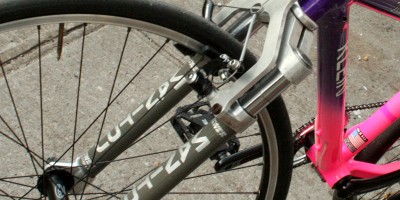
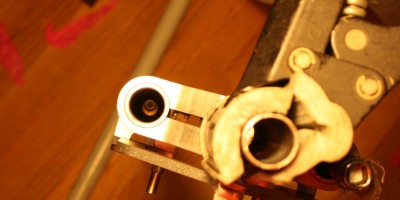
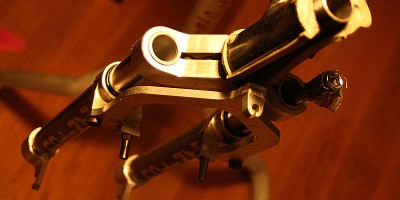


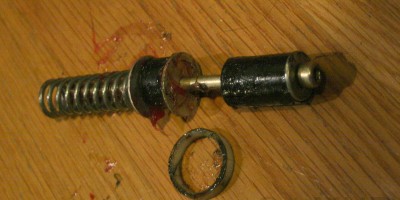



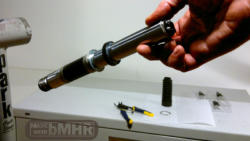
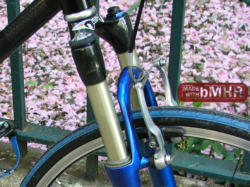







Mighty useful. Make no mistake, I appreciate it.
What a nice thing to do for us old bike owners!! I really appreciate your trouble posting this, it’s a fantastic help!!!! billy r
Glad I could assist!
Any suggestions on where to buy the springs?
I got these springs at a Lowes hardware department. Look for springs with the ends ground flat.
HELLO from Italy!!
I pawn a vintage Ritchey with this Manitou fork, but elastomers are gone away years ago!!
I have big troubles in finding hardware you used to restore fork, nere in Italy we have metric and, well, we don’t even have those big hardware stores you have in Usa.
Can you Help me???
Would you purchase all hardware needed (long Allen, Springs, rubbers and seals ) and ship it to me in Italy? I’m gonna pay you using Paypal, if not a problem or I can seno you cash by registered airmail.
you would have a lifelong friend in Italy :-)
My other option is to replace Manitou with a rigid fork…but this was the bike I used to ride in the first 90’s and I would love to have it restored in like new conditions, I’m getting old and a little bit nostalgic :-)
Please, forgive my bad english and let me kindly know
Thank you
Luca – Italy
Luca Muca Mangano in Facebook!
Ciao Luca,
Come stai? Your english is good.
Yes those elastomers decompose. I would send you a set of parts, but I don’t keep an inventory. Really, most of the parts are already inside – the long screw, the wide washers (they keep the stack from going off center during compression), seals and bushings. All you really need to find are springs; they can be approximately sized. They could be valve springs from a small engine, or springs for a door…
(the black rubber I used is a piece of tube, a fuel line from a car)
Also the tool you need, a 6mm allen socket, and a very long socket extension. Not impossible to find.
Go to a tractor store or motorcycle shop to ask for springs.
If you can’t find springs locally, I know there are some rebuild kits on ebay, though they are expensive.
Tell me how it goes.
Do you mind if I quote a few of your posts as long as I provide credit and sources back to your weblog? My blog is in the very same niche as yours and my users would truly benefit from a lot of the information you present here. Please let me know if this alright with you. Thank you! effcdbeeegdbcaga
Surely. Share the science I always say. What is your blog?
Thanks a bunch for taking the time to post this! I have an old Trek with a shot Manitou fork that I thought I was going to have to junk… but it looks like it’ll live to see another day thanks to you! Cheers!
Glad I could help.
Give the rebuild a try; it’s worth it.
Tell us how it goes.
Big help! Much more useful than diagram from suspension fork parts.com!
Hey, glad I can help.
Hey! What an absolutely essential piece of information to cover! Not much is available on the internet about these early Manitou forks so I appreciate you sharing your knowledge and experience.
I was given an old Monster Fat who’s Manitou 2’s were missing the 120mm(130mm?) M6 Allen bolt that runs through the elastomers (also missing.) The dust seals are both shot, one of the upper nylon bushings is cracked, and both lower bushings are missing. I didn’t even know there were lower bushings until I saw your post!
Would it be possible to measure the bushings so that the information is preserved on the internet? It would also help me get my bike on the road again. I’d get bushings machined if they are by chance not standard and could send you a set. Are the dust seals for these forks special order at this point?
Thank you again!
Hey JP,
Great, I am glad this helps! These early forks are excellent and worth restoration.
Yeah, I can see that it would have been wise to measure those things, so they could be hand made. But that bike has been returned to the wild, and not available to me.
I imagine you are up for some trial and error. You can get the bushing OD from your top bushing (-wear), it’ll be snug but not an interference fit. Use a tough plastic that resists friction wear; I’d be tempted to start with a piece of pvc pipe, but it’s surely too soft. The dust seals are less critically sized, I imagine using seals from another fork would work.